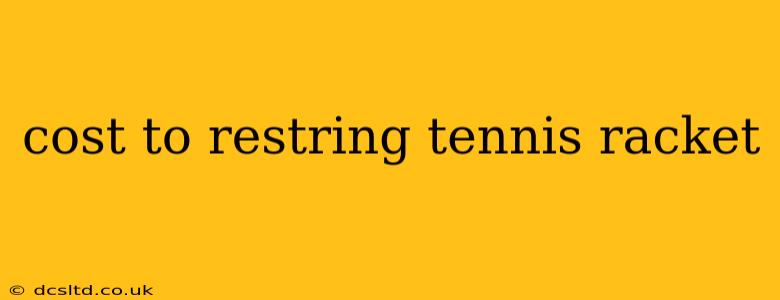Restringing your tennis racket is crucial for maintaining optimal performance and preventing injuries. But how much will it cost? The answer, unfortunately, isn't a simple number. The price varies significantly depending on several factors. This comprehensive guide will break down the costs, helping you budget effectively for your next restringing.
What Factors Influence the Cost of Restringing a Tennis Racket?
Several factors contribute to the overall cost of restringing your tennis racket. Understanding these will help you get a realistic estimate and avoid unexpected expenses.
1. String Type and Gauge:
This is arguably the biggest cost driver. Natural gut strings are the most expensive, offering exceptional feel, power, and comfort, but their lifespan is shorter. Synthetic strings, such as polyester, nylon, and co-polyester, offer a wider range of price points and performance characteristics. Thicker gauges (lower numbers like 16) are generally more durable but can feel less responsive, while thinner gauges (higher numbers like 18) offer more feel and control but break more easily.
2. String Tension:
Higher string tension generally increases control and reduces power, while lower tension increases power and comfort. While the tension itself doesn't directly impact the cost of restringing, your desired tension might influence the time and expertise required, potentially impacting the labor charge slightly. Highly specialized tension requests might incur a small additional fee.
3. Racket Type:
Some rackets have more complex frame designs that require more time and precision for restringing. This can slightly increase the labor cost.
4. Location and Restringer:
The location and experience level of the restringer significantly impact the price. High-end tennis shops in urban areas typically charge more than smaller, local businesses. Specialized restringers who work with professional players might charge premium rates.
5. Additional Services:
Some restringers offer additional services such as grip replacement, grommet replacement, or racket customization, which will increase the overall cost.
How Much Does it Typically Cost?
While it's impossible to give a precise number, here's a general range:
- Budget-Friendly Option: $25 - $40 (using basic synthetic strings and a standard restringing service)
- Mid-Range Option: $40 - $70 (using higher-quality synthetic strings or a blend, potentially including a tension adjustment)
- High-End Option: $70+ (using natural gut strings, specialized string patterns, or premium services from a high-end restringer)
How Often Should I Restring My Tennis Racket?
This depends on several factors including your playing frequency, string type, and playing style. As a general rule:
- Frequent Players (multiple times a week): Every 4-6 weeks
- Moderate Players (once or twice a week): Every 6-8 weeks
- Infrequent Players (less than once a week): Every 2-3 months
Inspect your strings regularly for signs of wear and tear, such as fraying or broken strings. Don't wait until your strings break completely; it can damage your racket frame.
Where Can I Get My Racket Restrung?
You can find restringing services at:
- Local Tennis Shops: These often offer a range of string choices and services.
- Sporting Goods Stores: Larger stores may have restringing services available, but the selection might be more limited.
- Online Restringing Services: Some companies offer mail-in restringing services, but shipping costs should be factored into the total cost.
Remember to inquire about pricing and service options before leaving your racket for restringing.
Can I Restring My Racket Myself?
While possible, restringing a racket is a highly skilled task requiring specialized tools and knowledge. Attempting to do it yourself without proper training can lead to damage to your racket or even injury. It's generally recommended to leave this to a professional.
This guide provides a comprehensive overview of the costs associated with restringing a tennis racket. By understanding the factors that influence the price, you can make informed decisions and ensure your racket is always in top playing condition.
